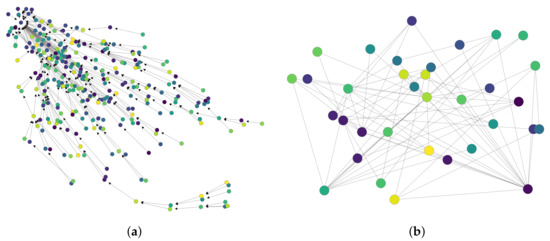You're using an outdated browser. Please upgrade to a modern browser for the best experience.
Please note this is a comparison between Version 1 by Wenyi Zhang and Version 2 by Camila Xu.
The widespread dissemination of rumors (fake information) on online social media has had a detrimental impact on public opinion and the social environment. This necessitates the urgent need for efficient rumor detection methods.
- rumor detection
- multi-hop graph
- differential time series
- spatiotemporal features
1. Introduction
Since the advent of the Internet era, online social networks have become an indispensable part of our lives. Platforms such as Twitter, Facebook, and Sina Weibo, which focus on social networking or possess social networking attributes, have become primary channels for people to access and share information on a daily basis. However, the exponential growth of content on social media platforms has been accompanied by a proliferation of rumors (fake information), which has had a detrimental impact on the online social environment [1]. The widespread dissemination of rumors distorts facts, leading individuals toward erroneous positions and thereby undermining the public opinion within social networks and posing a serious threat to society [2].
Detection methods and intervention strategies for rumors on social networking platforms have received considerable attention. Facebook encourages users to actively flag suspicious information, while Sina Weibo has established a dedicated Weibo Community Management Center to handle user reports of fake information. However, these existing approaches rely solely on manual verification which, although typically accurate, is limited in effectiveness due to the complexity of the identification process and the constraints of human resources in practical application. Consequently, an increasing number of researchers have been dedicating efforts to developing algorithms for detecting rumors, with the aim of automatically identifying rumors on the internet and addressing the challenges posed by the overwhelming volume of rumors that surpass the capacity of manual verification.
Early automatic rumor detection methods primarily relied on traditional machine learning. Researchers utilized feature engineering to model information from various dimensions of rumor events, followed by supervised training of classifiers to classify rumors and non-rumors. For instance, the authors of [3] employed decision trees, those for [4] utilized random forests, and the authors of [5][6][5,6] employed support vector machines (SVMs). These methods demonstrated certain rumor detection capabilities but heavily depended on feature engineering, thus exhibiting noticeable limitations. In recent years, however, deep neural networks (DNNs) have gained popularity, eliminating the need for intricate feature engineering. By training on raw data alone, DNNs can achieve optimal performance, making them widely applicable in the field of rumor detection. For instance, the authors of [7] employed recurrent neural networks (RNNs) to learn the textual content of rumors, while those for [8] utilized convolutional neural networks (CNNs) to extract textual information. Furthermore, with the development of graph neural networks (GNNs) and RNNs, effective modeling of the spatiotemporal features of rumors has become feasible. For instance, the authors of [9] used a tree-structured recursive neural network for propagation feature extraction, and those for [10][11][10,11] employed graph convolutional neural networks (GCNs) for structural feature extraction. The authors of [12] captured text and propagation features using a graph encoder and decoder model, and those for [13] utilized gated recurrent units (GRUs) to extract a rumor’s temporal and propagation features. These methods have demonstrated excellent performance in rumor detection tasks.
Despite the effective progress made in previous work, several issues still remain. First, existing methods primarily utilize GNNs based on message-passing frameworks to learn the structural features of rumors. However, the propagation of rumors follows a tree structure that unfolds based on time and interaction relationships, with the information source serving as the root node. The connectivity within rumor propagation graphs is relatively simple, but the depth exceeds that of typical graphs. Figure 1 illustrates the distinction between typical graphs and rumor propagation graphs. The characteristics of rumor propagation graphs pose limitations on the application of existing GNN frameworks for rumor detection tasks. Specifically, when faced with deeper node relationships, traditional GNNs can only aggregate information from high-order neighboring nodes by stacking multiple layers. However, this approach leads to issues such as oversmoothing of node features and gradient vanishing, resulting in performance degradation of the network [14][15][14,15]. Therefore, a challenge lies in how to better extract the interaction relationships among multi-hop neighbors within rumor propagation graphs.

Figure 1. (a) A sample from the real-world Weibo dataset representing the propagation process of a specific rumor event. (b) A sample from the Les Misérables Co-Occurrence Network dataset, constructed based on Victor Hugo’s novel Les Misérables, representing the network graph of character relationships. Rumor propagation graphs often exhibit a significant distance from the root node to the leaf nodes, while typical graphs lack a discernible root node, with all nodes maintaining a high level of connectivity.
Furthermore, the current approaches for extracting the temporal features of rumors, whether based on dynamic graphs [16][17][18][19][16,17,18,19] or time series [20][21][20,21], only focus on learning features at the level of the original semantic information. However, some studies have indicated that word embeddings, which are used to represent semantic information, possess certain distinctive properties. By analyzing arithmetic operations on word embeddings, the authors of [22] discovered that certain word embedding models can encode linguistic relational patterns. Moreover, the authors of [23][24][25][23,24,25] conducted case studies on the meanings of individual neurons in word embeddings and found systematic distributions of different linguistic attributes within the embeddings. This allows to consider word embeddings as relatively stable signals and obtain their changing information through differential operation. The advantage of modeling differential time series explicitly is that rumor features can be extracted from a perspective that varies in time series.
